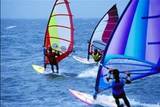Winnipeg Windsurfing

The legendary winds of Lake Winnipeg may have struck fear into many a lake-going mariner, but to speed-loving windsurfers in the Lake's southern basin, the breezes are a blessing. Tie down your board and head to any of the Lake's southern beaches, from Gimli in the northwest to Victoria in the northeast. (Be sure to surf Grand Beach on your way 'round!) Early spring and late fall are the windiest seasons on Winnipeg, but they are also downright chilly: you will need a dry suit, a hood, boots and gloves.
Wind-surfing is a surface water sport using a windsurf board, also commonly called a sailboard
Windsurfing evolved as a sport in the 1970s, when smaller lighter sails were put on surfboards, offering the trills of sailing at a very low cost, and in a package transportable on the roof of a car. When the original patent expired in the mid-1980s, a wider variety of sailboards were produced, and athletes began pushing the envelope, performing flips, and going as fast as 80 km/h (50 mph).
This multi-million dollar industry became an Olympic sport at the 1984 Los Angeles Summer Games. The best way to learn windsurfing is to start on land, learning to control the sail and maintain your balance. Then you progress to shallow water in a light wind, and steadily progressing to deeper waters and stronger winds.
Windsurfing can be done on the open sea, or on a tiny lake with any wind above a breeze. (In Canada, hardcore windsurfers continue into the winter as long as the ice remains thin).
Windsurfing combines the board from surfing with the sail of a small sailboat, hinged on a flexible mast pivot. Because there is little hull below water, and therefore little water resistance, speeds can be very high. To windsurf, you should be fit and agile, and have a good sense of balance (though this takes some practice).
What is wind surfing? a sport and recreational activity, needs a experience
The sport combines aspects of both sailing and surfing, along with certain athletic aspects shared with other board sports like skateboarding, snowboarding, waterskiing, wakeboarding and kitesurfing. Although it might be considered a minimalistic version of a sailboat, a windsurfer offers experiences that are outside the scope of most other sailing craft design.
Windsurfing includes speed sailing, slalom, course racing, wave sailing, superX, and freestyle as distinct disciplines.
Though windsurfing is possible in winds from near 0 to 50 knots, the ideal planing conditions for most recreational sailors is 15-25 knots, with lighter winds resulting in displacement mode sailing.
Author: Fredrick Buetefuer
